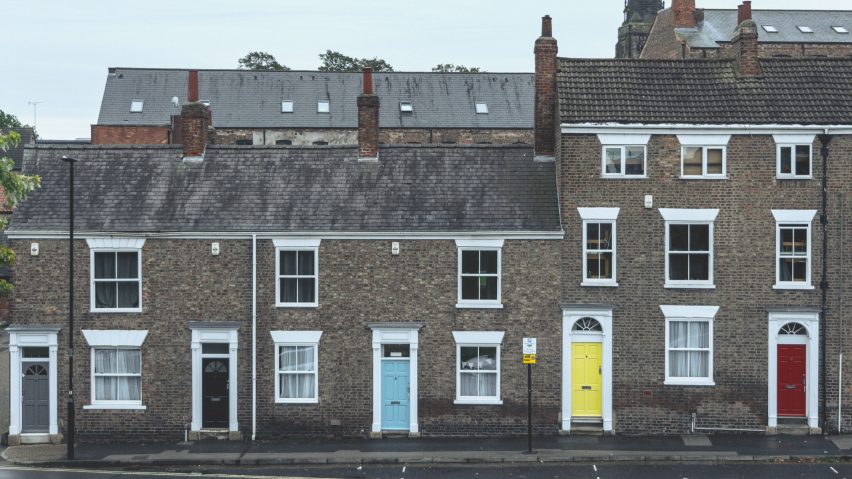
Michael Gove supports idea of school for "traditional architecture and urbanism"
UK housing secretary Michael Gove has supported a paper calling for a new architecture school in the UK that focuses on the teaching of traditional design principles.
Named A School of Place, the paper was published by the right-wing think-tank Policy Exchange and features a foreword written by Gove that hails the idea.
The report proposes that the UK government establishes a new architectural institution that will teach students the techniques to "wholeheartedly revive traditional architecture".
Its aim is to reduce opposition to new housing schemes and help to create "beautiful places".
This aligns with a wider government strategy called the Building Better Building Beautiful Commission, which was set up in 2018 to improve the design standard of homes and neighbourhoods.
Specifically, it echoes the sentiments of the commission's final report – Living With Beauty – which claimed a skills gap was preventing a "higher quality urban environment".
School would "wholeheartedly revive traditional architecture"
Written by architect and author Ike Ijeh, A School of Place makes a case for a new school that applies principles of traditionalism and classicism to contemporary architecture.
According to the text, it would champion "traditional architecture and urbanism principles that have perhaps been poorly represented in contemporary architectural education".

"The new School of Place will seek to wholeheartedly revive traditional architecture from the annals of obscurity to which contemporary architectural education has unfairly consigned it," writes Ijeh.
"It will further make rigorous attempts to ensure that none of the institutional or professional bias that can be said to have been waged against classicism or traditionalism is reflected in either its syllabus or curriculum."
However, while traditional design principles and techniques would form a significant part of the school's curriculum, it claims that they would not be studied exclusively, in order to prevent hostility from the architecture community.
Paper acknowledges school could cause "hostile reaction"
"Such diplomacy is necessary because the unfortunate fact remains that any perceived political bias towards traditionalism would provoke an immediate and hostile reaction from many within the architectural community, as seen by the hysterical response in some architectural circles to the government's inauguration of the Building Beautiful Building Better Commission," the report states.
"Such a reaction would inevitably stigmatise and alienate the school from the very professional community it is seeking to solicit," it continues.
In his foreword, Gove welcomes the paper and claims that education is key to improving the standards of placemaking design in the UK.
"I am pleased to see this paper contribute so productively to the debate on how we improve our homes and communities," said Gove.
"We must do all we can to ensure a new generation of built environment professionals are armed with the best skills and techniques possible to enable them to go out and build beautiful, sustainable places in which people and communities can thrive."
Gove suggests school would improve "standard of design"
Gove does not explicitly back the call for traditionalist architecture training, though he does suggest that this could lead to "a general improvement in the standard of design".
"Much of the opposition to new housing developments is often grounded in a fear that the quality of the new buildings and places created will be deficient and therefore detrimental to existing neighbourhoods and properties," said Gove.
"If a general improvement in the standard of design reassures the general public that this will in fact not be the case, then they may be less likely to oppose it," he continued.
"Rome was not built in a day. But it would never have been built at all if those who dedicated their lives and careers to its creation did not first know how to build it."
This reflects another claim in the report that there is "a critical disconnect between the architecture the public is given and the architecture the public wants".
Here, Ijeh refers to a poll by Policy Exchange in 2021, in which 84 per cent of respondents had a preference for traditional architectural style over modern architecture.
"This current level of disenfranchisement between architecture and the public it is meant to serve is both detrimental and unsustainable and cannot continue without risk of causing serious damage to public trust in architecture and public confidence in the planning system charged with delivering it," the report states.
The subject of traditionalism in architecture has also been prevalent in the US in recent years, after former US president Donald Trump passed an executive order in 2020 that stated new US government buildings had to be beautiful, citing classicism as a preferred style.
However, Joe Biden revoked the order after becoming president, just 69 days after it was signed.
In a recent interview with Dezeen, Tim Verlaan, an assistant professor at the Amsterdam Centre for Urban History, said that brutalism is at threat by right-wing politicians.
"Today, criticism on brutalism and modernism is mostly voiced by those on the far-right side of the political spectrum, precisely because of the association between modernism and the post-war welfare state," he told Dezeen.
"There is a connection to be made between the advent of neoliberal policies and the attack on the welfare state from the 1970s onwards and the mounting criticism of brutalism."
The main photo is by Gonzalo Facello via Unsplash.